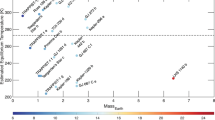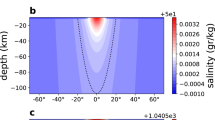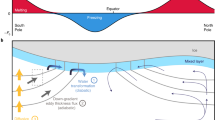Abstract
The discovery of the induced magnetic field of Callisto—one of Jupiter's moons—has been interpreted1,2 as evidence for a subsurface ocean, even though the presence of such an ocean is difficult to understand in the context of existing theoretical models3,4,5. Tidal heating should not be significant for Callisto, and, in the absence of such heating, it is difficult to see how this internal ocean could have survived until today without freezing1,6. Previous work3,4 indicated that an outer ice layer on the ocean would be unstable against solid-state convection, which once begun would lead to total freezing of liquid water in about 108 years. Here I show that when a methodology7 for more physically reasonable water ice viscosities (that is, stress-dependent non-newtonian viscosities, rather than the stress-independent newtonian viscosities considered previously) is adopted, the outer ice shell becomes stable against convection. This implies that a subsurface ocean could have survived up to the present, without the need for invoking antifreeze substances or other special conditions.
This is a preview of subscription content, access via your institution
Access options
Subscribe to this journal
Receive 51 print issues and online access
$199.00 per year
only $3.90 per issue
Buy this article
- Purchase on Springer Link
- Instant access to full article PDF
Prices may be subject to local taxes which are calculated during checkout

Similar content being viewed by others
References
Khurana, K. K. et al. Induced magnetic fields as evidence for subsurface oceans in Europa and Callisto. Nature 395, 777–780 (1998).
Zimmer, C., Khurana, K. K. & Kivelson, M. G. Subsurface oceans on Europa and Callisto: Constraints from Galileo magnetometer observations. Icarus 147, 329–347 (2000).
Reynolds, R. T. & Cassen, P. M. On the internal structure of the major satellites of the outer planets. Geophys. Res. Lett. 6, 121–124 (1979).
Cassen, P. M., Peale, S. J. & Reynolds, R. T. in Satellites of Jupiter (ed. Morrison, D.) 93–128 (Univ. Arizona Press, Tucson, 1982).
Schubert, G., Spohn, T. & Reynolds, R. T. in Satellites (eds Burns, J. A. & Matthews, M. S.) 224–292 (Univ. Arizona Press, Tucson, 1986).
Showman, A. P. & Malhotra, R. The Galilean satellites. Science 286, 77–84 (1999).
Solomatov, V. S. Scaling of temperature- and stress-dependent viscosity convection. Phys. Fluids 7, 266–274 (1995).
Anderson, J. D. et al. Distribution of rock, metals, and ices in Callisto. Science 280, 1573–1576 (1998).
Lewis, J. S. Satellites of the outer planets: thermal models. Science 172, 1127–1128 (1971).
Consolmagno, G. J. & Lewis, J. S. The evolution of icy satellite interiors and surfaces. Icarus 34, 280–293 (1978).
Stevenson, D. J. An ocean within Callisto? Eos 79, F535 (1998).
Kargel, J. S. Ammonia-water volcanism on icy satellites: Phase relations at 1 atmosphere. Icarus 100, 556–574 (1992).
Kargel, J. S. et al. Europa's crust and ocean: origin, composition, and the prospects for life. Icarus 148, 226–265 (2000).
Sotin, C., Grasset, O. & Beauchesne, S. in Solar System Ices (eds Schmitt, B., De Bergh, C. & Festou, M.) 79–96 (Kluwer Academic, Dordrecht, 1998).
Goldsby, D. L. & Kohlstedt, D. L. Grain boundary sliding in fine-grained ice I. Scripta Mater. 37, 1399–1406 (1997).
Pappalardo, R. T. et al. Geological evidence for solid-state convection in Europa's ice shell. Nature 391, 365–368 (1998).
McKinnon, W. B. Convective instability in Europa's floating ice shell. Geophys. Res. Lett. 26, 951–954 (1999).
Goldsby, D. L. & Kohlstedt, D. L. Superplastic deformation of ice: Experimental observations. J. Geophys. Res. (in the press).
Durham, W. B., Kirby, S. H. & Stern, L. A. The rheology of ice I at low stress and elevated confining pressure. J. Geophys. Res. (in the press).
Goldsby, D. L. & Kohlstedt, D. L. Flow of ice I by dislocation, grain boundary sliding, and diffusion processes. Lunar Planet. Sci. XXVIII, 429–430 (1997).
Showman, A. P. & Malhotra, R. Tidal evolution into Laplace resonance and the resurfacing of Ganymede. Icarus 127, 93–111 (1997).
Klinger, J. Influence of a phase transition of the ice on the heat and mass balance of comets. Science 209, 271–272 (1980).
Mueller, S. & McKinnon, W. B. Three-layered models of Ganymede and Callisto: Compositions, structures, and aspects of evolution. Icarus 76, 437–464 (1988).
Kirk, R. L. & Stevenson, D. J. Thermal evolution of a differentiated Ganymede and implications for surface features. Icarus 69, 91–134 (1987).
Davies, M. E. et al. The control networks of the Galilean satellites and implications for global shape. Icarus 135, 372–376 (1998).
McKinnon, W. B. in Solar System Ices (eds Schmitt, B., De Bergh, C. & Festou, M.) 525–550 (Kluwer Academic, Dordrecht, 1998).
Solomatov, V. S. & Moresi, L.-N. Stagnant lid convection on Venus. J. Geophys. Res. 101, 4737–4753 (1996).
Lupo, M. J. & Lewis, J. S. Mass-radius relationships in icy satellites. Icarus 40, 157–170 (1978).
Durham, W. B., Kirby, S. H. & Stern, L. A. Creep of water ices at planetary conditions: A compilation. J. Geophys. Res. 102, 16293–16302 (1997).
Kamb, B. in Flow and Fracture of Rocks (eds Heard, H. C., Borg, I. Y., Carter, N. L. & Raleigh, C. B.) 211–241 (AGU Geophys. Monogr. Ser. 16, American Geophysical Union, Washington DC, 1972).
Acknowledgements
I thank F. Anguita, O. Prieto, J. Ruiz, R. Tejero and A. Torices for suggestions, K. Bennett and J. Kargel for comments on the manuscript, and W. Durham and D. Goldsby for preprints of work in press.
Author information
Authors and Affiliations
Corresponding author
Rights and permissions
About this article
Cite this article
Ruiz, J. The stability against freezing of an internal liquid-water ocean in Callisto. Nature 412, 409–411 (2001). https://doi.org/10.1038/35086506
Received:
Accepted:
Issue Date:
DOI: https://doi.org/10.1038/35086506
This article is cited by
-
Magnetic Fields of the Satellites of Jupiter and Saturn
Space Science Reviews (2010)
-
LAPLACE: A mission to Europa and the Jupiter System for ESA’s Cosmic Vision Programme
Experimental Astronomy (2009)
-
Seas under ice: Stability of liquid-water oceans within icy worlds
Earth, Moon, and Planets (2006)
-
Models of the Internal Structure of Callisto
Solar System Research (2005)
Comments
By submitting a comment you agree to abide by our Terms and Community Guidelines. If you find something abusive or that does not comply with our terms or guidelines please flag it as inappropriate.



